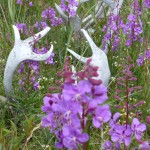
“Polar bears move as if the country has belonged to them always.”
John Muir, on a visit to the Arctic in 1899
Less than an hour after we landed in Churchill, Manitoba, Canada at the remote lodge on Hudson Bay, we saw our first polar bear. In fact, it was a cuddly-looking mother and cub who lumbered along the shoreline. We photographed them from the safety of the lodge windows and settled in for a “safety talk” before we headed out onto the Arctic tundra to track the bear on foot.

Safety? Our guides had over 15 years of combined experience with polar bears and you know it when they talk about the bears’ behavior, how close to get and how to read the bear’s body language. They carry ample deterrents such as guns, bear pepper spray and a radio. Their expertise and presence put me at ease. We never left the lodge without the armed  guides. We walked with the bears and accompanied them as they swam in Hudson Bay.
guides. We walked with the bears and accompanied them as they swam in Hudson Bay.
Seal River Heritage Lodge, one of the Churchill Wild lodges, is located right on the shoreline of Western Hudson Bay – . Churchill Wild is a pioneer in the realm of summer walking safaris to photograph bears and snorkel with beluga whales.
We hiked on the spongy tundra and along the rocky shores and observed the bears from amazingly close distances. It was easy to be lulled into forgetting that they are the deadliest of hunters.

The polar bear knows only how to hunt and kill for its next meal, as plants rarely turn up in its diet. “In a fight with a grizzly, I’d put my money on the polar bear. They are larger and heavier,” said Terry, our experienced guide.
“It’s as wild here as at the North Pole. And the amazing thing is how accessible this wilderness is. We’re right on the middle of North America with easy access to a major airport,” said Mike Reimer, co-owner with his wife Jeanne.

I started my journey in Winnipeg, Manitoba, a two hour flight from Denver. Then I flew two hours north to Churchill, a town reached only by plane or train. I was whisked by prop plane to the Seal River Heritage Lodge, (about 59′ north latitude) — a true wilderness far from trains, roads or town. Located on Hudson Bay, I spent the next five days stalking, with camera and binoculars the polar bears and pods of beluga whales in the bay, the birds and wildflowers.
FLOATING WITH BELUGA WHALES

White ghostlike shadows flashed beneath me as I floated in the 34-degree water of Hudson Bay, an extension of the Arctic Ocean. Although my dream was to see beluga whales up close while floating in their deep-blue home, it was suddenly frightening to be alone with them – far from the boat.
My heart raced as I zipped up the thick dry suit over two layers of fleece and thermal underwear. My adrenaline started pumping when I slipped into the water, put on my mask and snorkel, flipped over so my face was in the water. Terry, our guide tied a long rope around my ankles and let out the line. I was slowly dragged behind the slow-moving boat, staring into darkness. My hands, cheeks and forehead were cold, but I concentrated on singing underwater.
Yes, I sang, well rather hummed, with the snorkel in my mouth. Then I heard whistling and clicking around me. Beluga are called “Canary Whales” because they communicate with harmonics, clicks and high pitched sounds. My mind went blank and all I could repeat was the children’s song “Baby beluga” and “I’ve been working on the railroad.
Thousands of white beluga whales move from the northern Arctic to their summer home in Hudson Bay.
